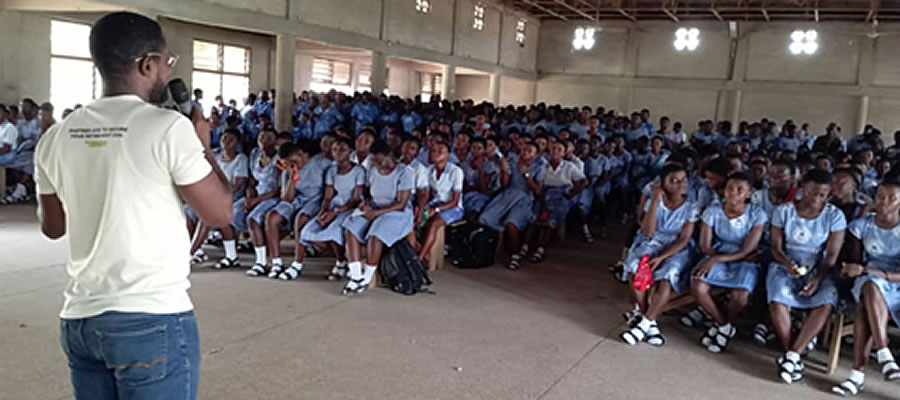

Disability
Persons with Disabilities (PWD) have been defined as those who are unable to or are restricted in the performance of specific tasks/activities due to loss of function of some part of the body as a result of impairment or malformation. Disability is now considered a societal development issue because of its direct relationship with poverty (Ghana Statistical Service, 2012).
In an attempt to understand the situation of PWDs as a guide for policy formulation, the Ghana Statistical Service, for the first time, collected specific data on PWDs in the 2010 Population and Housing Census. This chapter discusses the socio-economic and demographic characteristics of the population with disability in the district, the types of disability, distribution of PWD by type of locality, PWD and type of activity, and PWD by education and literacy.
Population with Disability
Table 6.1 presents results of population of people with disability in the District by type of disability, sex and type of locality. In all 2.1 percent of people in the District are people with various forms of disability. There are more female (52.2%) than males (47.8%) in the population of PWDs in the District.
Type of Disability
Figure 6.1 shows the distribution of types of disability. The most common form of disability is physical impairment, which accounts for 37.2 percent and this is followed by visual/sight impairment (34.2%) and people with hearing impairment (18.7%).
Distribution by type of locality
Table 6.1 shows the types of disability by type of locality in the District. In all 2.0 percent of the population in urban localities are PWDs as against (2.2%) in rural localities. Physical disability is predominant in urban localities while sight impairment leads among the cases of disabilities in rural localities.
Disability and Activity Status
Table 6.2 presents information on persons 15 years and older with disability by economic status and sex. The Table shows that, there are 2,307 persons or 1.6 percent of the Population 15 years and older with disability. About 57 percent of the persons with disability are employed whiles just 1.2 percent of these are unemployed. About 42.2 percent of all persons with a form of disability are economically not active according to the Table. Of the persons with emotional disability 60.2 percent are employed while those with sight disability 57.7 percent are employed with 41.7 percent of them being economically not active. Of all the disability types in the district those with speech have the highest number being unemployed with 1.8 percent.
With respect to gender males with all forms of disability that are employed represent 63.5 percent, 0.9 percent being unemployed and 35.6 percent also accounts for those who are economically not active. Males with hearing disability, 64.2 percent are employed and for those with physical and sight disability 37.3 percent each is economically not active in the district.
The total number of females with a form of disability 50.5 percent are employed, 1.5 percent unemployed and 48.0 percent being economically not active. Females with emotional disability 56.9 percent are employed and those with physical disability 60.6 percent are economically not active according to the table.
Disability and level of education
Table 6.3 presents the Population distribution of persons 3 years and older by sex, disability type and level of education. The results show that quite a large proportion (21.4%) of PWDs have never been to school, while more than half (60.6%) have attained basic education and just 8.4 percent have sec/SHS and higher educational attainment. Of all the persons with a form of disability 41.4 percent have never been to school, 49.4 percent have basic education and 6.2 percent have sec/SHS and higher education.
Of the persons with hearing disability, 52.1 percent have never been to school, 55.1 of those with emotional disability have basic education and 7.1 percent of the physical disability have sec/SHS and higher education.
For total males in the district, 15.6 percent have never been to school, 63.5 percent have basic education and 11.2 percent have sec/SHS and higher education in the district according to table 6.3. The table further indicates that with males with a disability, 28.1 percent have never been to school and 59.0 percent have basic education and exactly 10.0 percent have sec/SHS and higher education.
Females who have never been to school accounts for 27.2 percent, basic education 57.2 percent and 5.5 percent with sec/SHS and higher education. For those with a form of disability, 53.5 percent have never been to school, 40.7 percent basic education and 2.8 percent with sec/SHS and higher education which all imply that most of the persons with disability at least have basic education in the district as revealed by the data from the 2010 population and housing census.
Date Created : 11/17/2017 1:29:35 AM













 facebook
facebook
 twitter
twitter
 Youtube
Youtube
 +233 593 831 280
+233 593 831 280 0800 430 430
0800 430 430 GPS: GE-231-4383
GPS: GE-231-4383 info@ghanadistricts.com
info@ghanadistricts.com Box GP1044, Accra, Ghana
Box GP1044, Accra, Ghana